Registered with the Registrar of Newspapers for India under R.N.I 53640/91
Vol. XXVI No. 24, April 1-15, 2017
He inspired another to get into scripophily
Pradipto Mohapatra, who passed away recently, was a true polymath. Ram Mohan, in a tribute to him, says, “He was the rarest among Indian executives, a man with much wider and deeper interests than merely making money or running businesses efficiently. Many people knew him as a connoisseur of watches, antique and contemporary, from his articles in several luxury watch supplements; he was a regular invitee to international horology fairs besides. More importantly, he was always ready to share his views and offer help to those lucky enough to possess one or two valuable time-pieces on how to take better care of them.
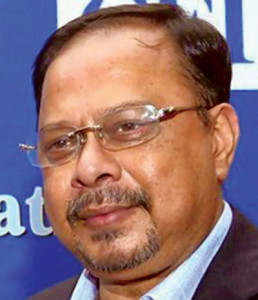 Pradipto Mohapatra
Pradipto Mohapatra
“He was an early and enthusiastic collector of art by many famous Indian artists, long before they were discovered by the regular art world. Pradipto was always surrounded, be it in his office or home, by his over-flowing collection of paintings, sketches and water-colours.
“He was a pioneering Indian scripophilist, a collector of rare bond and share certificates, and an authority on recorded music, having worked with the Gramophone Company of India (HMV). He was a passionate history buff.
“As a business executive, he reinvented himself from being a proper boxwallah in Dunlop to a trusted member of a traditional Indian group, RPG. Upon retirement he served many well-known companies, both in India and Sri Lanka (which he loved) on their Boards. In yet another facet of his personality, he provided critical advice to international clients in consulting roles. He was an entrepreneur too, having invested in a couple of start-ups in business coaching and business education, teaching and education another passion of his.
 Madras Presidency Khallikote Raj Sterling loan. This very large document, pertaining to a loan taken by a Maharaja from Orissa, comes with attached coupons for payment of interest periodically.
Madras Presidency Khallikote Raj Sterling loan. This very large document, pertaining to a loan taken by a Maharaja from Orissa, comes with attached coupons for payment of interest periodically.
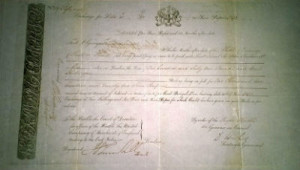
A document signed at Fort St. George in 1818, guaranteeing payment of interest on a portion of the Bengal Loan.
“He was always a speaker on demand and a storyteller par excellence, who enjoyed having an audience; no lunch or dinner with him would be complete without Pradipto holding forth with some anecdotal evidence about the topics being discussed. Like a true thinking man that he was, Pradipto always ended his stories with some amount of perspective – and what a glorious perspective it always was. While you are going home chuckling away at his humour, you would have to agree that he made you see things in a different light.”
A rare, multi-dimensional man, one of those Mohapatra inspired was Sayeed Cassim, who recently held an exhibition of his collection of historical coins and shares. He writes “it was a privilege to have known him,” and adds:
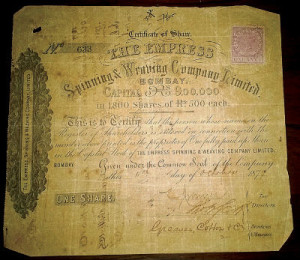
The Empress Spinning and Weaving Company Limited. This is the very first Tata Group company to have gone public. This also was probably the first mill to have been set up in Nagpur which was in the cotton-growing belt. (Bombay was the preferred location in those days.)
“I have since my schooldays been interested in anything unusual. Stamps etc. did not interest me, because they were so very common and you could lose track of what you had. The same applied to coins, which I collected for quite some time.
“A friend of mine introduced me to Pradipto Mohapatra at a talk he gave on scripophily a few years ago. I guess it was love at first sight. I had been an investor in the stock markets for over 30 years then. The beauty of share certificates is that, unlike any other collectible, they could almost speak for themselves. You could see for yourself the name of the company, which period it was issued in, where it was based, what business or industry it was involved in, who the promoters were, who owned the share and also who had purchased the share after that. Also these certificates were printed in the hundreds or maybe a few thousand as compared to a few million or even a few billion of stamps, coins and notes.
“These certificates also do not indulge in attention-seeking behaviour like other hobbies like, say, vintage cars nor do they take up too much space. They are particularly suitable as our homes are only getting smaller by the day.”
Editor’s Note: We publish on page 7 and here, some of the more striking certificates in Cassim’s collection.
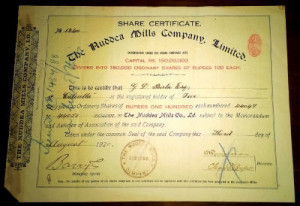
This Nuddea Mills Company Limited share certificate was issued to G.D. Birla.
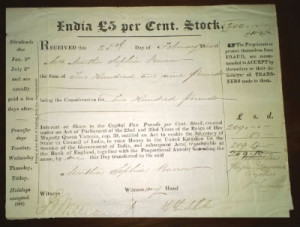
India £5 per cent stock issued in 1864. This has a very unusual way of mentioning the date, referencing it to the year of the reign of Her Majesty Queen Victoria.
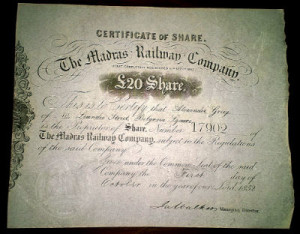
The Madras Railway Company. One of the early railway companies to have been set up. Date is mentioned in a very beautiful way: “On the first day of October in the year of our Lord 1852”.
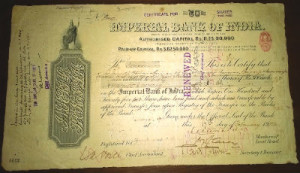

Imperial Bank of India. Certificate issued in 1922 is a very high value one of Rs. 30,000. Had a similar amount been invested in land at the same time it would be worth about Rs. 10,000 crore today. The certificate also has the who’s who (see names on reverse) of the Parsi community of that time, as joint owners. There are four knights of the Garter as co-owners at any given point of time. Highly unusual.
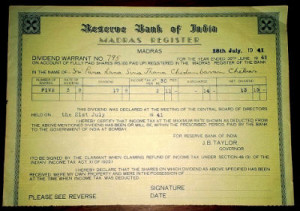
Dividend warrant of the Reserve Bank of India. Not many are aware that the Reserve Bank was privately held in those days.
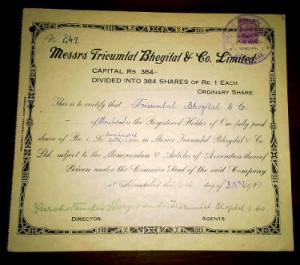
Tricumlal Bhogilal & Co. Ltd., Re. 1 share. The entire capital of the company was only
Rs. 384. Could probably be the company with the lowest authorised capital in the world.
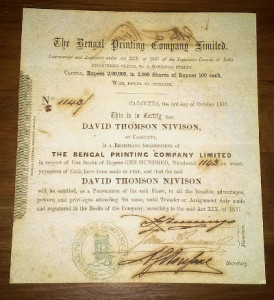
The Bengal Printing Company’s very beautiful certificate on vellum(a sheet of animal skin scraped thin). The certificate was printed by the Company itself. This may just qualify as the
world’s first ‘selfie’.

